Spectrophotometric Method for the Determination of Ciprofloxacin in Pure and Pharmaceutical Preparations: Development and Validation †
Abstract
1. Introduction
2. Materials and Methods
3. Result and Discussion
3.1. Absorption Spectra
3.2. Optimization of Reaction Conditions
3.3. Chemical Reactions of the Method
3.4. Calibration Curves and Analytical Data
3.5. Equivalent of the Reactions
3.6. Accuracy and Precision
3.7. Interference Study
3.8. Effect of Mixing Sequence
3.9. Application of the Method
4. Conclusions
Author Contributions
Funding
Institutional Review Board Statement
Informed Consent Statement
Data Availability Statement
Conflicts of Interest
References
- Karaman, R. Commonly Used Drugs—Uses, Side Effects, Bioavailability and Approaches to Improve It; Nova Science Publishers, Inc.: New York, NY, USA, 2015; p. 12. [Google Scholar]
- Brunton, L.L. The Pharmacological Basis of Therapeutics; The Mc. Graw-Hill Inc.: New York, NY, USA, 2006; p. 52. [Google Scholar]
- British Pharmacopoeia CD-ROM; System Simulation; The Stationery Office Ltd.: London, UK, 2013.
- Selahle, S.K.; Nomngongo, P.N. Determination of fluoroquinolones in the environmental samples using vortex assisted dispersive liquid–liquid microextraction coupled with high performance liquid chromatography. Int. J. Environ. Anal. Chem. 2020, 100, 282–294. [Google Scholar] [CrossRef]
- Hasan, N.; Siddiqui, F.A.; Sher, N.; Shafi, N.; Zubair, A.; Afzal, M. Development and validation of a Reverse Phase HPLC method for the analysis of ciprofloxacin and its application in bulk and different dosage formulations. World Appl. Sci. J. 2014, 31, 730–740. [Google Scholar]
- Saeed, A.M.; Salih, E.S. Indirect spectrofluorometric method for the determination of cefotaxime sodium, ciprofloxacin hydrochloride and famotidine in pharmaceuticals using bromate-bromide and acriflavine dye. Baghdad Sci. J. 2020, 17, 1–15. [Google Scholar]
- Turkey, N.S.; Khudhair, A.F. Determination of ciprofloxacin—HCl in pharmaceutical formulations by continuous flow injection analysis via turbidimetric (T180 o) and scattered light effect at two opposite position (2N90 o) using Ayah 4SW-3D-T180-2N90-Solar-CFI Analyser. J. Kerbala Univ. 2013, 11, 153–169. [Google Scholar]
- Akyüz, B.G.; Ozkorucuklu, S.P.; Kır, E.; Bastemur, G.Y. Determination of ciprofloxacin In pharmaceutical dosage, human serum and urine, using molecularly imprinted polymer modified electrode by voltammetry. Eur. J. Sci. Technol. 2020, 20, 859–865. [Google Scholar]
- Miloğlu, F.D.; Kadioglu, Y. Determination Of Ciprofloxacin With Zero–, First– And Second Order Derivative Spectrophotometric Method In Water And Methanol Media. Int. J. Pharm. 2022, 2, 16–24. [Google Scholar]
- Basavaiah, K.; Nagegowda, P.; Somashekar, C.B.; Ramakrishna, V. Spectrophotometric and Titrimetric Determination of Ciprofloxacin Based on Reaction with Cerium (IV) Sulphate. Sci. Asia 2006, 32, 403–409. [Google Scholar] [CrossRef]
- Al-Salim, L.A.S.M. The Use of Oxidation and Reduction Reactions for the Spectrophotometric Determination of a Number of Pharmaceutical Compounds. Master’s Thesis, Mosul University, Mosul, Iraq, 2018; pp. 60–80. [Google Scholar]
- Zareh, M.M.; Saad, M.Z.; Hassan, W.S.; Elhennawy, M.E.; Sebaiy, M.M. Validation of spectrophotometric method for determination of esomeprazole and ciprofloxacin in their pure and dosage forms. Int. J. Pharm. Sci. Dev. Res. 2020, 6, 001–005. [Google Scholar]
- Igboasoiyi, A.C.; Attih, E.E.; Ofoefule, S.I.; Umoh, E.D.; Udoh, O.C. Spectrophotometric determination of ciprofloxacin using charge-transfer complexation technique. Int. J. Innov. Res. Dev. 2014, 3, 152–177. [Google Scholar]
- Abdullah, M.B.; Salih, E.S. Indirect Spectrophotometric Determination of Famotidine and Ciprofloxacin Hydrochloride in Pharmaceuticals Using N-Bromosuccinimde and Janus Green B Dye. J. Educ. Sci. 2022, 31, 38–57. [Google Scholar] [CrossRef]
- Kóska, I.; Purgat, K.; Głowacki, R.; Kubalczyk, P. Simultaneous Determination of Ciprofloxacin and Ofloxacin in Animal Tissues with the Use of Capillary Electrophoresis with Transient Pseudo-Isotachophoresis. Molecules 2021, 26, 6931. [Google Scholar] [CrossRef] [PubMed]
- Parker, S.P. McGraw-Hill Dictionary of Chemistry, 1st ed.; International Edition; McGraw-Hill Book Company: New York, NY, USA, 1986; pp. 274, 346, 575, 644. [Google Scholar]
- Commision of the European Communities. Validation of Analytical Procedures. 1996. Available online: https://www.ema.europa.eu/en/documents/scientific-guideline/ich-guideline-q2r1-validation-analytical-procedures-text-and-methodology-step-5-first-version_en.pdf (accessed on 1 December 2023).
- Kishore, M.; Surendrababu, K.; Kalyani, C.S.R.G.; Janrdhan, M. Optimization of quantitative analysis of buclizine hydrochloride using spectrophotometry in bulk drug and pharmaceutical formulations. Int. J. Curr. Pharm. Res. 2010, 2, 48–51. [Google Scholar]
- Khopkar, S.M. Basic Concepts of Analytical Chemistry, 2nd ed.; New Age Int. Ltd.: New Delhi, India, 2004; p. 240. [Google Scholar]

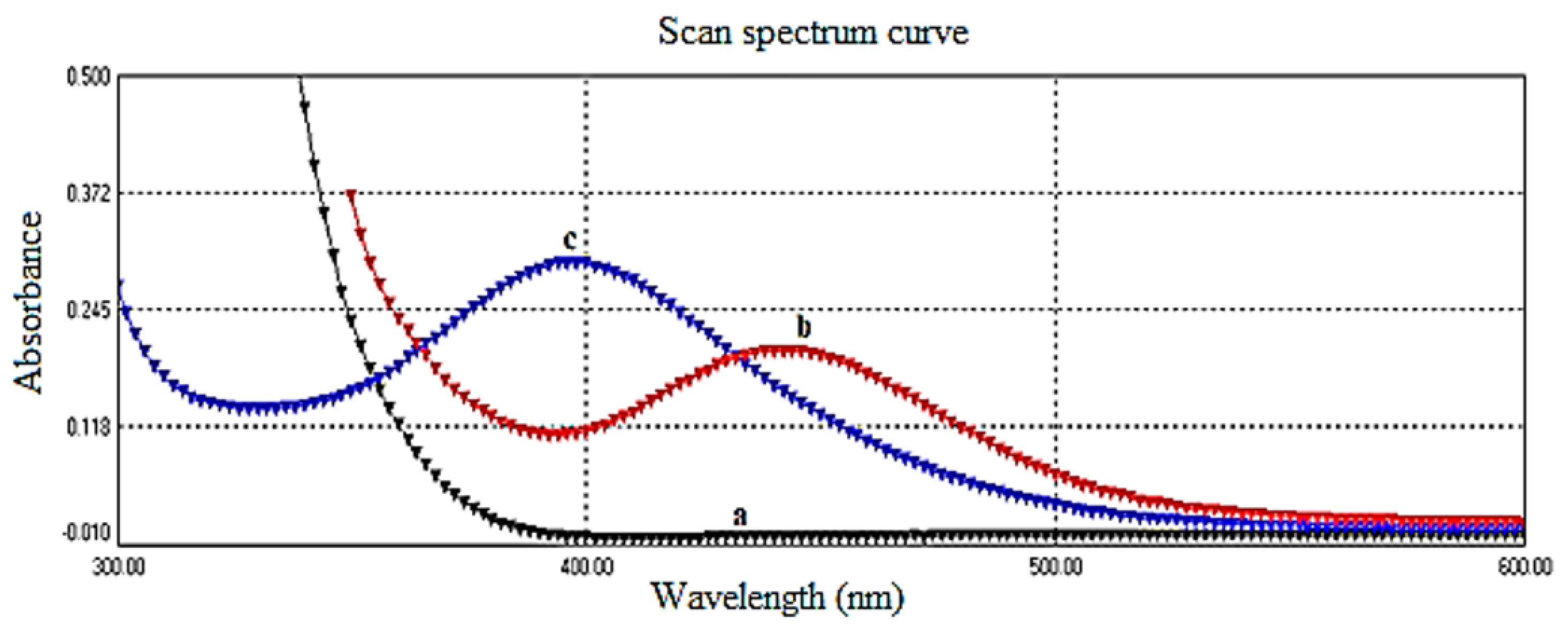
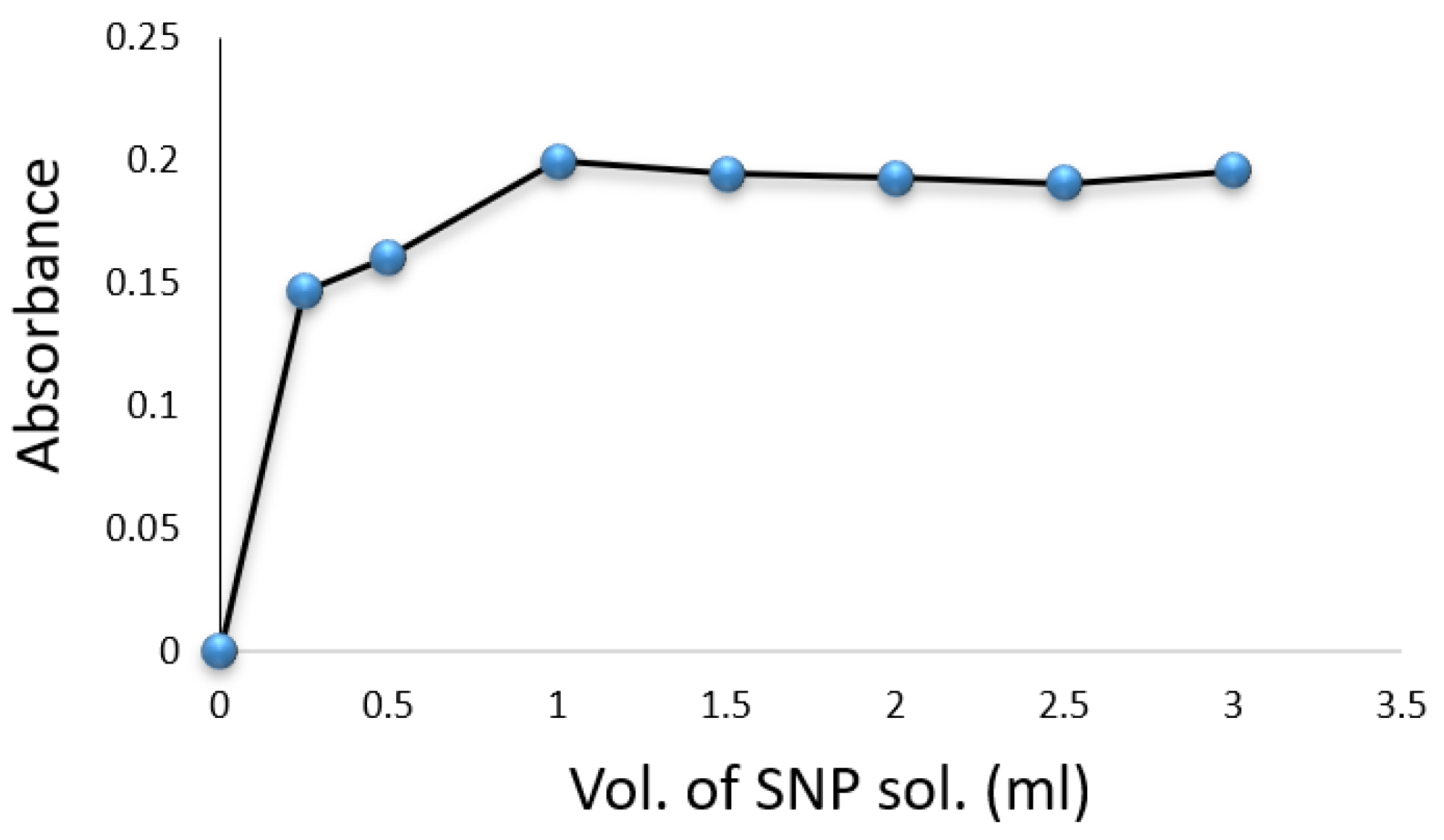
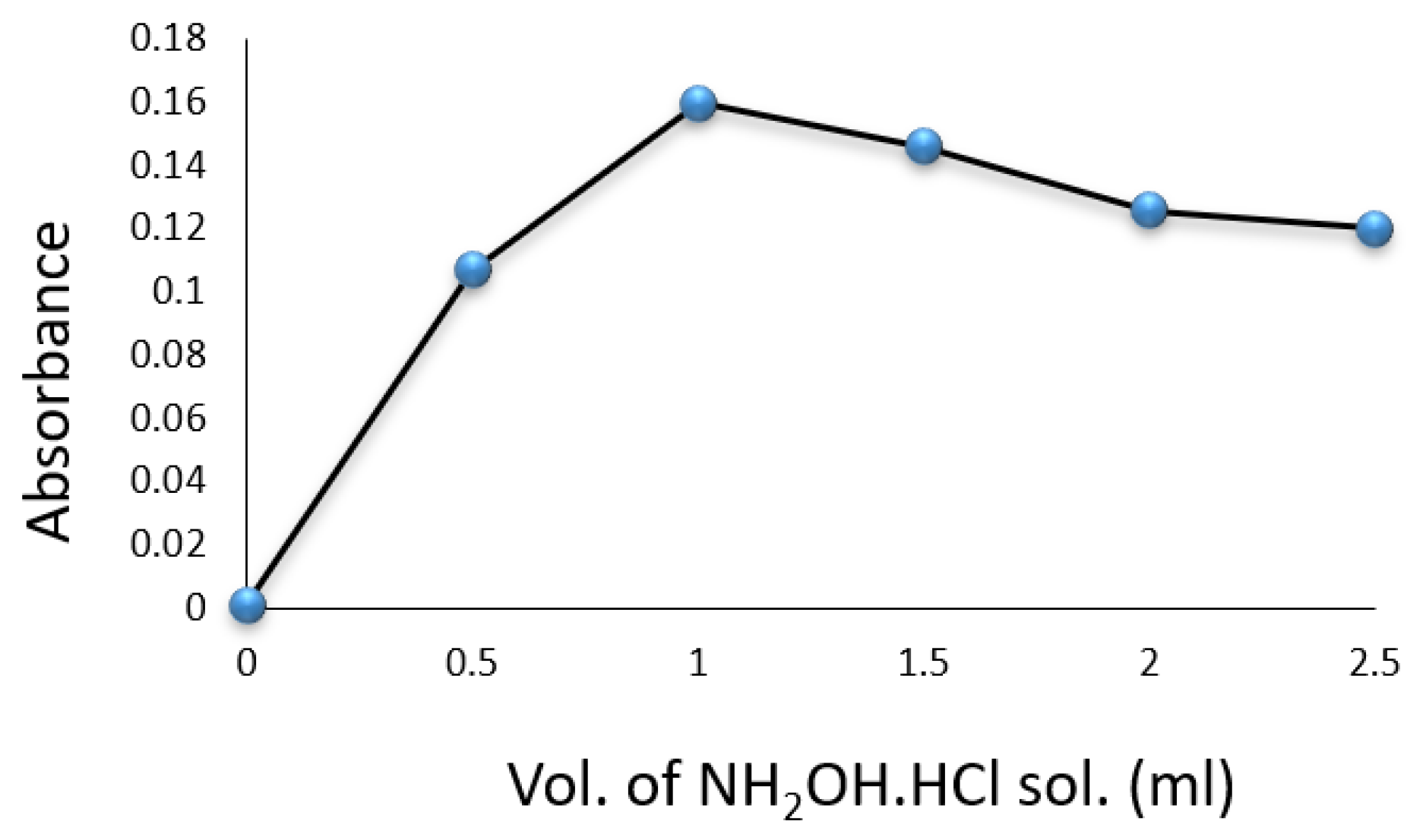

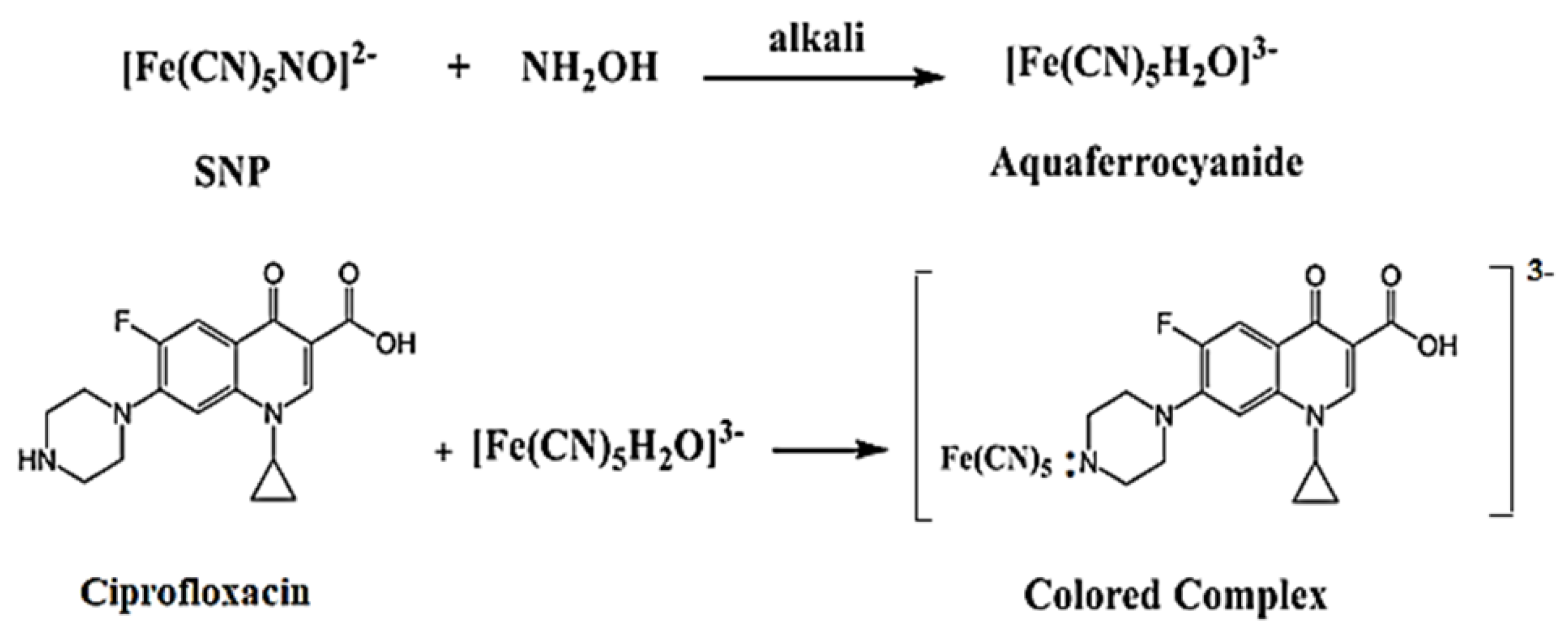
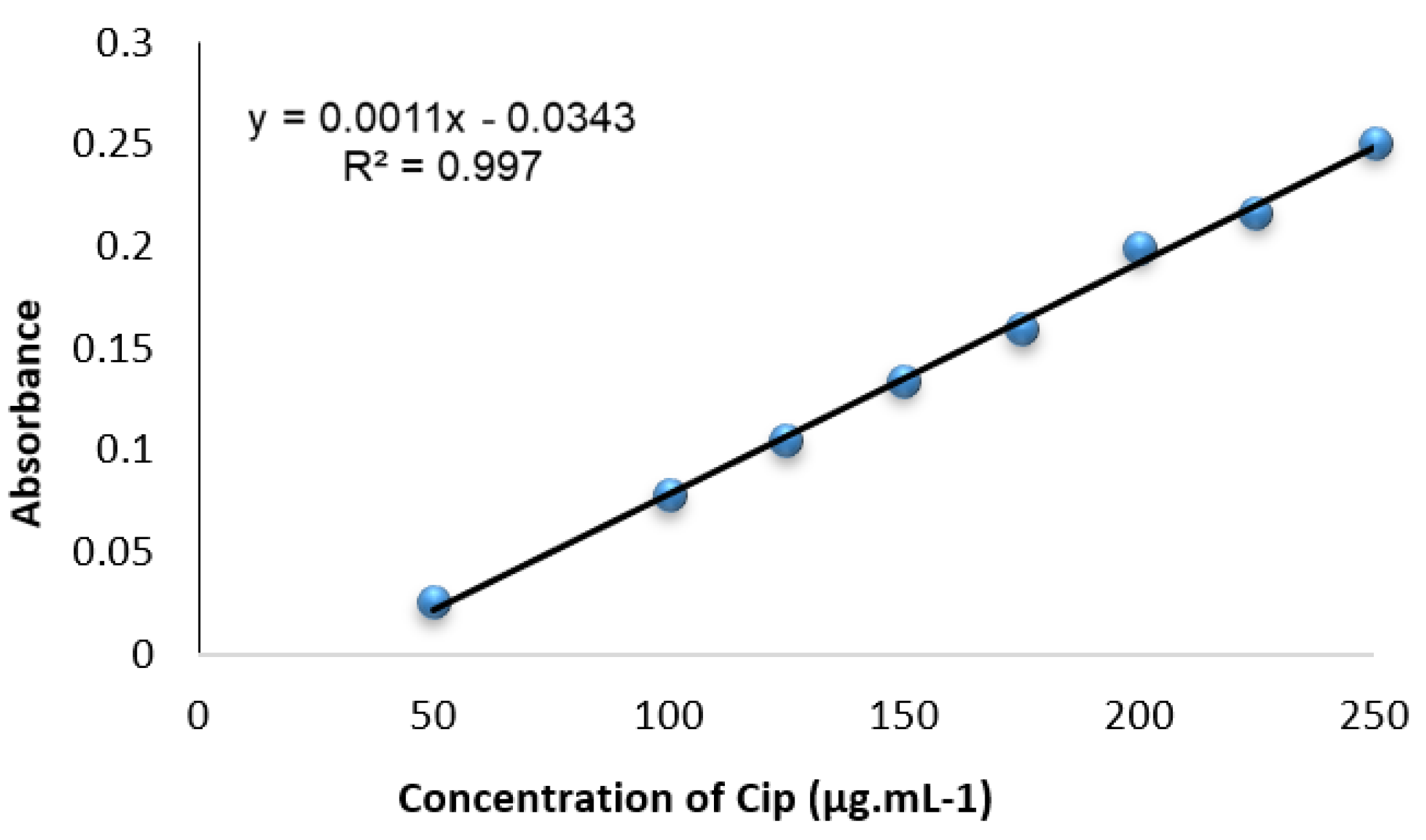
| Time (min) | Absorbance |
|---|---|
| 3 | 0.185 |
| 5 | 0.201 |
| 6 | 0.202 |
| 7 | 0.203 |
| 8 | 0.197 |
| 10 | 0.199 |
| 15 | 0.200 |
| Temperature (°C) | Absorbance |
|---|---|
| 15 | 0.154 |
| 20 | 0.182 |
| 25 | 0.202 |
| 30 | 0.198 |
| 35 | 0.183 |
| 40 | 0.172 |
| 45 | 0.165 |
| Parameter | Value |
|---|---|
| max (nm) | 440.0 |
| Color | Yellow |
| Linearity range () | 50.0–250.0 |
| Regression equation | |
| Calibration sensitivity () | 0.0011 |
| Correlation coefficient (r) | 0.99849 |
| Correlation of linearity () | 0.997 |
| Molar absorptivity () | 364.4817 |
| Sandell’s sensitivity () | 0.90909 |
| Detection limit () | 12.57 |
| Quantification limit () | 41.909 |
| Mole ratio (R/D) | 2:1 |
| Conc. of Chloramphenicol (μg/mL) | Recovery (%) | Relative Error (%) | C.V. * (%) | |
|---|---|---|---|---|
| Taken | Found | |||
| 100.000 | 99.899 | 99.899 | 0.101 | 0.6823 |
| 150.000 | 149.965 | 99.976 | 0.024 | 0.2314 |
| 200.000 | 199.891 | 99.945 | 0.055 | 0.08911 |
| Excipients | Concentration (μg/mL) | Ciprofloxacin Conc. Taken (200.0 μg/mL) | |
|---|---|---|---|
| Conc. Found * (μg/mL) | Recovery * (%) | ||
| Acacia | 1000 | 199.52 | 99.76 |
| Glucose | 197.97 | 98.985 | |
| Lactose | 199.71 | 99.855 | |
| Starch | 198.98 | 99.49 | |
| Sucrose | 200.11 | 100.055 | |
| Order | 1st | 2nd | 3rd | 4th | Abs. |
|---|---|---|---|---|---|
| Order 1 | Cip. | SNP | NH2OH | Base | 0.201 |
| Order 2 | SNP | Cip. | NH2OH | Base | 0.200 |
| Order 3 | Base | Cip. | SNP | NH2OH | 0.166 |
| Order 4 | SNP | NH2OH | Cip. | Base | 0.158 |
| Order 5 | SNP | Base | Cip. | NH2OH | 0.163 |
| Order 6 | SNP | NH2OH | Base |
| Marketed Formulation | Certified Value (μg·mL−1) | Found Value (μg·mL−1) | Recovery % | Relative Error % | C.V. * % |
|---|---|---|---|---|---|
| Cipro-Denk 500 mg/tablets. Denk Pharma—Germany. | 200.00 | 195.77 | 97.885 | 2.115 | 1.833 |
| Ciproxin 500 mg/capsule. Karachi Sindh. | 200.00 | 198.094 | 99.047 | 0.953 | 1.366 |
Disclaimer/Publisher’s Note: The statements, opinions and data contained in all publications are solely those of the individual author(s) and contributor(s) and not of MDPI and/or the editor(s). MDPI and/or the editor(s) disclaim responsibility for any injury to people or property resulting from any ideas, methods, instructions or products referred to in the content. |
© 2024 by the authors. Licensee MDPI, Basel, Switzerland. This article is an open access article distributed under the terms and conditions of the Creative Commons Attribution (CC BY) license (https://creativecommons.org/licenses/by/4.0/).
Share and Cite
Mahmoud, T.Y.; Hamza, I.S.; Jarallah, A.L. Spectrophotometric Method for the Determination of Ciprofloxacin in Pure and Pharmaceutical Preparations: Development and Validation. Eng. Proc. 2023, 59, 164. https://doi.org/10.3390/engproc2023059164
Mahmoud TY, Hamza IS, Jarallah AL. Spectrophotometric Method for the Determination of Ciprofloxacin in Pure and Pharmaceutical Preparations: Development and Validation. Engineering Proceedings. 2023; 59(1):164. https://doi.org/10.3390/engproc2023059164
Chicago/Turabian StyleMahmoud, Tariq Yassin, Isam Shaker Hamza, and Aziz Latif Jarallah. 2023. "Spectrophotometric Method for the Determination of Ciprofloxacin in Pure and Pharmaceutical Preparations: Development and Validation" Engineering Proceedings 59, no. 1: 164. https://doi.org/10.3390/engproc2023059164
APA StyleMahmoud, T. Y., Hamza, I. S., & Jarallah, A. L. (2023). Spectrophotometric Method for the Determination of Ciprofloxacin in Pure and Pharmaceutical Preparations: Development and Validation. Engineering Proceedings, 59(1), 164. https://doi.org/10.3390/engproc2023059164





